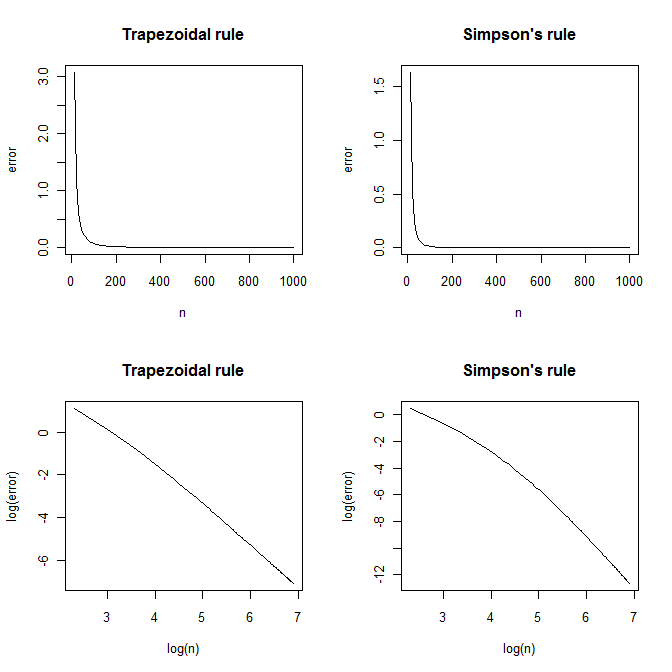one-dimensional integrals
The foundamental idea of numerical integration is to estimate the area of the region in the xy-plane bounded by the graph of function f(x). The integral was esimated by dividing x into small intervals, then adds all the small approximations to give a total approximation.
Trapezoidal rule
Numerical integration can be done by trapezoidal rule, simpson’s rule and quadrature rules. R has a built-in function, integrate, which performs adaptive quadrature.
Trapezoidal rule works by approximating the region under the graph f(x) as a trapezoid and calculating its area.
trapezoid <- function(fun, a, b, n=100) {
# numerical integral of fun from a to b
# using the trapezoid rule with n subdivisions
# assume a < b and n is a positive integer
h <- (b-a)/n
x <- seq(a, b, by=h)
y <- fun(x)
s <- h * (y[1]/2 + sum(y[2:n]) + y[n+1]/2)
return(s)
}
Simpson’s rule
Simpson’s rule subdivides the interval [a,b] into n subintervals, where n is even, then on each consecutive pairs of subintervals, it approximates the behaviour of f(x) by a parabola (polynomial of degree 2) rather than by the straight lines used in the trapezoidal rule.
simpson <- function(fun, a, b, n=100) {
# numerical integral using Simpson's rule
# assume a < b and n is an even positive integer
h <- (b-a)/n
x <- seq(a, b, by=h)
if (n == 2) {
s <- fun(x[1]) + 4*fun(x[2]) +fun(x[3])
} else {
s <- fun(x[1]) + fun(x[n+1]) +
2*sum(fun(x[seq(2,n,by=2)])) +
4 *sum(fun(x[seq(3,n-1, by=2)]))
}
s <- s*h/3
return(s)
}
To calculate an integrate over infinite interval, one way is to transform it into an integral over a finite interval as introduce in wiki.
simpson_v2 <- function(fun, a, b, n=100) {
# numerical integral using Simpson's rule
# assume a < b and n is an even positive integer
if (a == -Inf & b == Inf) {
f <- function(t) (fun((1-t)/t) + fun((t-1)/t))/t^2
s <- simpson_v2(f, 0, 1, n)
} else if (a == -Inf & b != Inf) {
f <- function(t) fun(b-(1-t)/t)/t^2
s <- simpson_v2(f, 0, 1, n)
} else if (a != -Inf & b == Inf) {
f <- function(t) fun(a+(1-t)/t)/t^2
s <- simpson_v2(f, 0, 1, n)
} else {
h <- (b-a)/n
x <- seq(a, b, by=h)
y <- fun(x)
y[is.nan(y)]=0
s <- y[1] + y[n+1] +
2*sum(y[seq(2,n,by=2)]) +
4 *sum(y[seq(3,n-1, by=2)])
s <- s*h/3
}
return(s)
}
> phi <- function(x) exp(-x^2/2)/sqrt(2*pi) ##normal distribution
> simpson_v2(phi, 0, Inf, n=100)
[1] 0.4986569
> simpson_v2(phi, -Inf,3, n=100)
[1] 0.998635
> pnorm(3)
[1] 0.9986501
Simpson’s rule is more accuracy than trapezoidal rule. To compare the accuracy between simpson’s rule and trapezoidal rule, I estimated $ \int_{0.01}^{1} \frac{1}{x} dx = -\log(0.01)$ for a sequence of increasing values of n.
f <- function(x) 1/x
#integrate(f, 0.01, 1) == -log(0.01)
S.trapezoid <- function(n) trapezoid(f, 0.01, 1, n)
S.simpson <- function(n) simpson(f, 0.01, 1, n)
n <- seq(10, 1000, by = 10)
St <- sapply(n, S.trapezoid)
Ss <- sapply(n, S.simpson)
opar <- par(mfrow = c(2, 2))
plot(n,St + log(0.01), type="l", xlab="n", ylab="error", main="Trapezoidal rule")
plot(n,Ss + log(0.01), type="l", xlab="n", ylab="error",main="Simpson's rule")
plot(log(n), log(St+log(0.01)),type="l", xlab="log(n)", ylab="log(error)",main="Trapezoidal rule")
plot(log(n), log(Ss+log(0.01)),type="l", xlab="log(n)", ylab="log(error)",main="Simpson's rule")

The plot showed that log(error) against log(n) appears to have a slope of -1.90 and -3.28 for trapezoidal rule and simpson’s rule respectively.
Another way to compare their accuracy is to calculate how large of the partition size n for reaching a specific tolerance.
yIntegrate <- function(fun, a, b, tol=1e-8, method= "simpson", verbose=TRUE) {
# numerical integral of fun from a to b, assume a < b
# with tolerance tol
n <- 4
h <- (b-a)/4
x <- seq(a, b, by=h)
y <- fun(x)
yIntegrate_internal <- function(y, h, n, method) {
if (method == "simpson") {
s <- y[1] + y[n+1] + 4*sum(y[seq(2,n,by=2)]) +
2 *sum(y[seq(3,n-1, by=2)])
s <- s*h/3
} else if (method == "trapezoidal") {
s <- h * (y[1]/2 + sum(y[2:n]) + y[n+1]/2)
} else {
}
return(s)
}
s <- yIntegrate_internal(y, h, n, method)
s.diff <- tol + 1 # ensures to loop at once.
while (s.diff > tol ) {
s.old <- s
n <- 2*n
h <- h/2
y[seq(1, n+1, by=2)] <- y ##reuse old fun values
y[seq(2,n, by=2)] <- sapply(seq(a+h, b-h, by=2*h), fun)
s <- yIntegrate_internal(y, h, n, method)
s.diff <- abs(s-s.old)
}
if (verbose) {
cat("partition size", n, "\n")
}
return(s)
}
> fun <- function(x) exp(x) - x^2
> yIntegrate(fun, 3,5,tol=1e-8, method="simpson")
partition size 512
[1] 95.66096
> yIntegrate(fun, 3,5,tol=1e-8, method="trapezoidal")
partition size 131072
[1] 95.66096
As show above, simpson’s rule converge much faster than trapezoidal rule.
Quadrature rule
Quadrature rule is
more efficient than traditional algorithms. In adaptive quadrature, the subinterval width h is not constant over the interval [a,b], but instead adapts to the function. Here, I presented the adaptive simpson’s method.
quadrature <- function(fun, a, b, tol=1e-8) {
# numerical integration using adaptive quadrature
quadrature_internal <- function(S.old, fun, a, m, b, tol, level) {
level.max <- 100
if (level > level.max) {
cat ("recursion limit reached: singularity likely\n")
return (NULL)
}
S.left <- simpson(fun, a, m, n=2)
S.right <- simpson(fun, m, b, n=2)
S.new <- S.left + S.right
if (abs(S.new-S.old) > tol) {
S.left <- quadrature_internal(S.left, fun, a, (a+m)/2, m, tol/2, level+1)
S.right <- quadrature_internal(S.right, fun, m, (m+b)/2, b, tol/2, level+1)
S.new <- S.left + S.right
}
return(S.new)
}
level = 1
S.old <- (b-a) * (fun(a) + fun(b))/2
S.new <- quadrature_internal(S.old, fun, a, (a+b)/2, b, tol, level+1)
return(S.new)
}
Quadrature rule is effective when f(x) is steep.
> fun <- function(x) return(1.5 * sqrt(x))
> system.time(yIntegrate(fun, 0,1, tol=1e-9, method="simpson"))
partition size 524288
user system elapsed
1.58 0.00 1.58
> system.time(quadrature(fun, 0,1, tol=1e-9))
user system elapsed
0.25 0.00 0.25
Reference
- Robinson A., O. Jones, and R. Maillardet. 2009. Introduction to Scientific Programming and Simulation Using R. Chapman and Hall.
- http://en.wikipedia.org/wiki/Numerical_integration
- http://en.wikipedia.org/wiki/Trapezoidal_rule
- http://en.wikipedia.org/wiki/Simpson%27s_rule
- http://en.wikipedia.org/wiki/Adaptive_quadrature